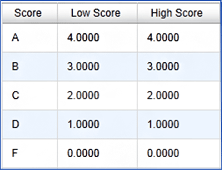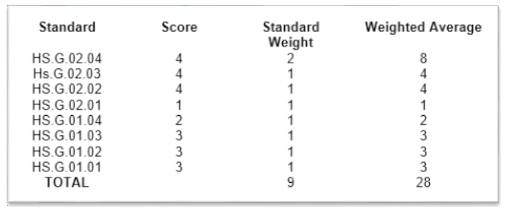Standards Grading Method
Understanding Standards Final Mark Methods
When using academic standards in Grade Book, a student’s overall grade
can be determined either from traditional assignment data or from standards
data. When determining a student’s overall grade from standards data,
Grade Book first determines the student’s overall proficiency on each
standard assessed.
From there, the individual standard results can be either:
Averaged to determine an overall class grade
(Weighted Mean).
OR
Passed to the Standards Mark Definition
Matrix to determine an overall class grade (Mark Definition Matrix).
Weighted Mean
When averaging standards to determine an overall grade, a student’s
proficiency on each standard is multiplied by the weight of the standard.
The sum of all of the ‘weighted’ standards is then divided by the sum
of the assessed standards weights – this number is then passed to the
Report Card Score Type to determine the final grade.

Weighted mean averages standards performance across all standards
to determine overall grade.
Allows standards to have different weights. Weighting is a
multiplier that allows some standards to contribute more to the overall
grade.
Category weighting and term weighting are NOT factored into
the overall grade.
Allows standards to be assessed with different score types.
EXAMPLE:
Consider the following example of a student’s overall proficiency on
eight standards and the effects of Weighted Mean methods of determining
an overall grade.

How this student’s overall grade was determined:

The student’s Overall Grade is 3.11 (Weighted Average (28) / Standard
Weight (9)). Based on the Report Card Score Type shown previously, the
mark for a 3.11 is a B.
Mark Definition Matrix
When using the Standards Mark Definition Matrix to determine overall
grades (using a 4-point Rubric standards as an example), the percentage
of 4’s, 3’s, 2’s, and 1’s a student earns on assessed standards is passed
to a district-defined matrix.

Mark definition matrix uses the criteria defined in the grid
to determine overall grade. To get a particular grade the student
must match the criteria defined in that row.
Marks are processed according to their sequence. The first
mark criteria matching the student’s performance will be the mark
given.
Category weighting and term weighting are NOT factored into
the overall grade.
Allows standards to be assessed with different score types.
Final grade configuration settings do not control the mark
given.
All teachers who have their final grades calculated from standards
will use this setting.
EXAMPLE:
Consider the following example of a student’s overall proficiency on
eight standards and the effects of Mark Definition Matrix methods of determining
an overall grade.

How the student’s overall grade was determined:

To earn an A, B, or C using the Standards Mark Definition Matrix shown
previously, the student cannot have earned any “1”s. In this example the
student has earned one “1,” so he is disqualified from earning these marks.
To earn a D, the student must earn greater than 50% 4’s and 3’s and less
than 33% 1’s. This student earned 75% ‘4’s and ‘3’s and 12.5% ‘1’s. The
student’s overall grade is a D.
Tasks







 Set Standards
Grading Method
Set Standards
Grading Method